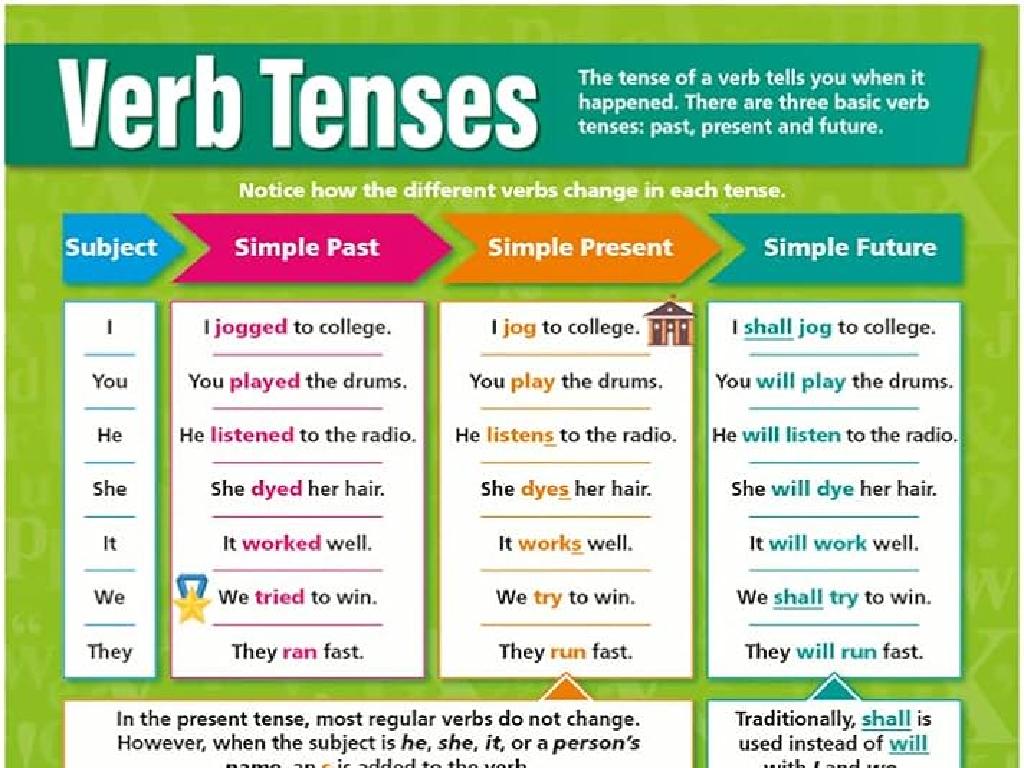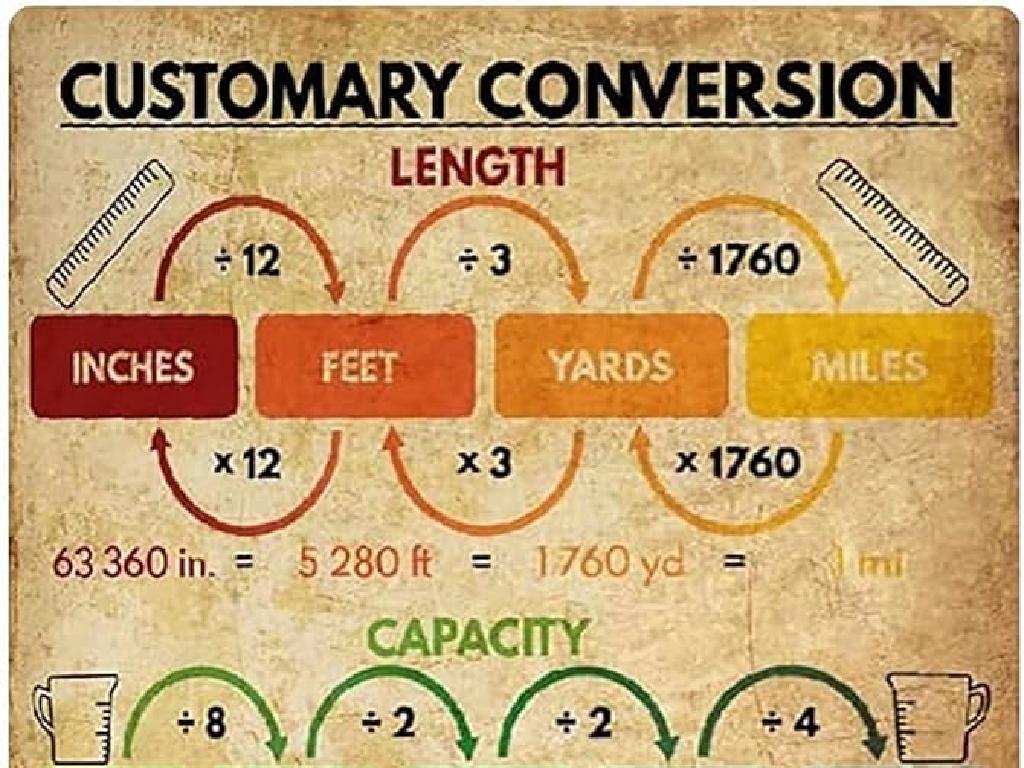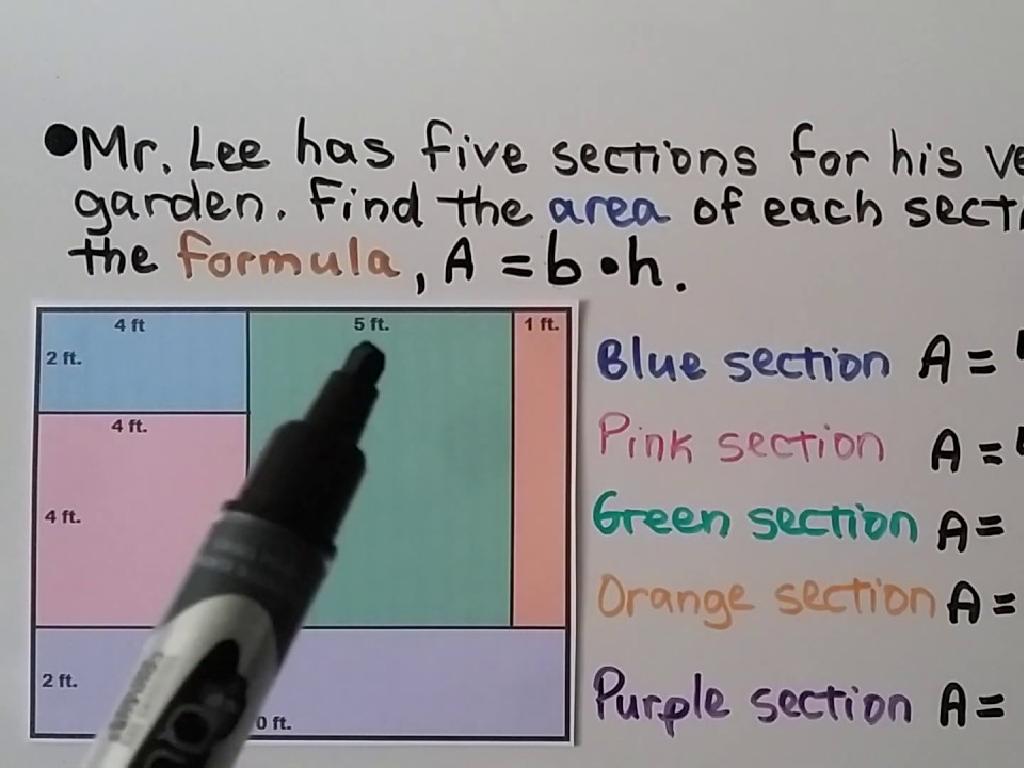Acute, Obtuse, And Right Triangles
Subject: Math
Grade: Fourth grade
Topic: Triangles
Please LOG IN to download the presentation. Access is available to registered users only.
View More Content
Exploring Triangles
– Triangles: A special shape
– Three sides and three angles
– Each angle of a triangle adds up to 180 degrees.
– Types: Acute, Obtuse, Right
– Acute: All angles less than 90°, Obtuse: One angle more than 90°, Right: One angle exactly 90°
– Recognizing triangle types
– Look at angles to tell them apart
|
Begin the class with a warm welcome and an introduction to triangles, emphasizing their uniqueness as a shape with three sides and three angles. Explain that the sum of the angles in any triangle is always 180 degrees. Introduce the three types of triangles based on their angles: acute, obtuse, and right. Use visual aids to help students recognize each type by sight. Acute triangles have all angles less than 90 degrees, obtuse triangles have one angle greater than 90 degrees, and right triangles have one angle that is exactly 90 degrees. Encourage students to practice by drawing each type and identifying triangles around the classroom or at home.
Exploring Triangles
– A triangle has three sides
– Angles add to 180 degrees
– No matter the triangle, the angles inside always add up to 180°
– Triangles have different types
– Some are acute, some obtuse, and some right
– Classification by angles and sides
– Like isosceles, equilateral, or scalene based on side lengths
|
Introduce the concept of a triangle by discussing its basic properties, such as having three sides and three angles. Emphasize that the sum of the interior angles of any triangle is always 180 degrees. Explain that triangles can be classified in different ways, primarily by their angles (acute, obtuse, right) and by their sides (isosceles, equilateral, scalene). Use visual aids to help students remember the different types of triangles. Provide examples of each type and encourage students to draw their own. Discuss how to classify triangles both by angle and by side length, and explain that some triangles can fit into more than one category (e.g., an isosceles right triangle).
Exploring Triangle Types by Angles
– Acute Triangle: All angles 90°
– Example: Angles of 100°, 40°, 40° make an obtuse triangle.
|
This slide introduces students to the classification of triangles based on their angles. An acute triangle has all angles measuring less than 90 degrees, which means it’s sharp at all corners. A right triangle has one angle that is exactly 90 degrees, resembling the corner of a square. An obtuse triangle has one angle that is greater than 90 degrees, making it look ‘stretched’ at one corner. Use everyday objects to help students visualize these types of triangles, such as a slice of pizza for an acute triangle, a book for a right triangle, and a fan for an obtuse triangle. Encourage students to draw their own examples and measure the angles to reinforce the concept.
Identifying Triangles by Angles
– Examples of different triangles
– Look at shapes and determine type: acute, obtuse, or right
– Measure angles in degrees
– Angles less than 90° are acute, equal to 90° are right, and more than 90° are obtuse
– Practice with triangle worksheet
– Use your worksheet to identify each triangle’s type
– Recognize acute, obtuse, right
– Acute: all angles 90°
|
This slide is aimed at helping fourth-grade students understand how to identify different types of triangles based on their angles. Begin by showing examples of acute, obtuse, and right triangles. Explain that the type of triangle is determined by the measure of its angles. Provide a worksheet with various triangles for students to practice identifying the type of each triangle. Encourage students to use a protractor to measure angles if possible. Discuss the characteristics of each type of triangle: acute triangles have all angles less than 90 degrees, right triangles have one angle exactly 90 degrees, and obtuse triangles have one angle greater than 90 degrees. This activity will help solidify their understanding of triangle classification.
Exploring Acute Triangles
– All angles under 90 degrees
– Each angle is smaller than a right angle
– Acute triangles appear ‘sharp’
– They have a ‘pointy’ look, unlike obtuse triangles
– Equilateral triangles are acute
– All angles are equal and less than 90 degrees
– Recognizing acute triangles
|
This slide introduces acute triangles, emphasizing that all interior angles are less than 90 degrees. Highlight the visual aspect of acute triangles by describing them as ‘sharp’ or ‘pointy’, which can help students remember their shape. Use an equilateral triangle as a concrete example of an acute triangle, where all angles are not only less than 90 degrees but also equal to each other. Encourage students to practice recognizing acute triangles by looking at various shapes and determining if all angles are acute. Provide several examples of different acute triangles and ask students to draw their own.
Exploring Right Triangles
– Right triangles: one 90-degree angle
– A right angle looks like the corner of a square
– Recognizable by their ‘square’ corner
– 3-4-5 triangle, where sides meet at a right angle
– Example: Pythagorean triple triangle
– Useful in real-world problems
– Helps in construction, navigation, etc.
|
This slide introduces right triangles, which are a special type of triangle with one angle measuring exactly 90 degrees. The ‘square’ corner is a visual cue for identifying right triangles. A classic example is the Pythagorean triple, such as a triangle with sides of 3, 4, and 5 units, which always forms a right angle. Understanding right triangles is crucial as they are used in various real-world applications, such as construction, navigation, and solving problems involving right angles. Encourage students to look for right angles in their environment and to use a square corner as a tool to identify right triangles.
Exploring Obtuse Triangles
– One angle over 90 degrees
– An obtuse triangle has one angle that is larger than a right angle.
– Appears ‘blunt’ or ‘spread out’
– The triangle looks like it’s not sharp or pointy at one corner.
– Example: 100°, 40°, and 40° triangle
– A triangle with one angle measuring 100° and the other two angles both measuring 40° is obtuse.
|
This slide introduces students to obtuse triangles, which are a type of triangle with one angle measuring more than 90 degrees. Explain that the word ‘obtuse’ can be remembered because these triangles are not sharp or pointy; they appear more ‘blunt’ or ‘spread out’. Use the example of a triangle with angles of 100 degrees, 40 degrees, and 40 degrees to illustrate an obtuse triangle. Encourage students to draw their own obtuse triangles and measure the angles to reinforce the concept.
Properties of Triangles
– Triangles: Sides and Vertices
– A triangle has 3 sides that meet at 3 corners, or vertices.
– Right Triangle and Hypotenuse
– In a right triangle, the longest side opposite the right angle is the hypotenuse.
– Unique Properties of Triangles
– Each type of triangle has its own special features and measurements.
|
This slide introduces students to the fundamental properties of triangles. Emphasize that all triangles have three sides and three vertices, which are the points where the sides meet. Explain that the hypotenuse is a term specific to right triangles and is the longest side, found opposite the right angle. Highlight that while all triangles share some properties, each type (acute, obtuse, and right) has unique characteristics that set them apart. Use diagrams to illustrate the different types of triangles and their properties. Encourage students to think of examples of each type of triangle they may encounter in real life.
Class Activity: Triangle Hunt
– Search for triangles in the classroom
– Find acute, right, and obtuse triangles
– Draw and label each triangle found
– Use a ruler for straight lines and label angles
– Discuss the triangle types with classmates
– Share your findings and learn from others
|
This activity is designed to help students apply their knowledge of triangle types in a fun and interactive way. Encourage the students to look for real-world examples of acute, right, and obtuse triangles in the classroom, such as on posters, desks, or bookshelves. Provide them with paper and rulers for accurate drawing and labeling. After the hunt, facilitate a discussion where students can present their drawings and explain how they identified each type of triangle. This will reinforce their understanding and allow them to learn from each other’s discoveries. Possible variations of the activity could include finding triangles in groups, using digital tools to draw, or even creating a triangle collage with the collected examples.
Triangle Mastery Recap
– Congrats on the Triangle Hunt!
– Recall each triangle type
– Acute: all angles 90°
– Practice identifying triangles
– Try to spot and classify triangles wherever you can
– Keep observing your surroundings!
|
Well done to all the students for completing the Triangle Hunt activity! It’s important to remember the key differences between acute, right, and obtuse triangles as this knowledge is fundamental to understanding geometry. Encourage the students to keep practicing by identifying triangles in their everyday environment, such as in art, buildings, and nature. This will help solidify their understanding and make learning fun. As a teacher, you can plan future activities that involve triangle identification to further reinforce these concepts.





